Advanced Financial Accounting: Enron Case Study - Accounting Misuse
VerifiedAdded on 2023/06/04
|11
|2967
|274
Case Study
AI Summary
This case study examines Enron's misuse of accounting concepts, focusing on mark-to-market accounting and special purpose entities (SPEs). It details how Enron exploited these methods to inflate its financial performance and mislead investors. The analysis covers the inappropriate application of mark-to-market accounting to assets where it was not suitable, and the use of SPEs to conceal debt and manipulate financial reporting objectives. Furthermore, the case study explores how Enron's top management benefited from high compensation and stock options, highlighting the role of agency theory in understanding their motivations. The study also discusses the elements of financial statements and different measurement methodologies used by companies, providing a comprehensive overview of the accounting practices and ethical failures that led to Enron's downfall. Desklib offers this and other solved assignments to aid students in their studies.
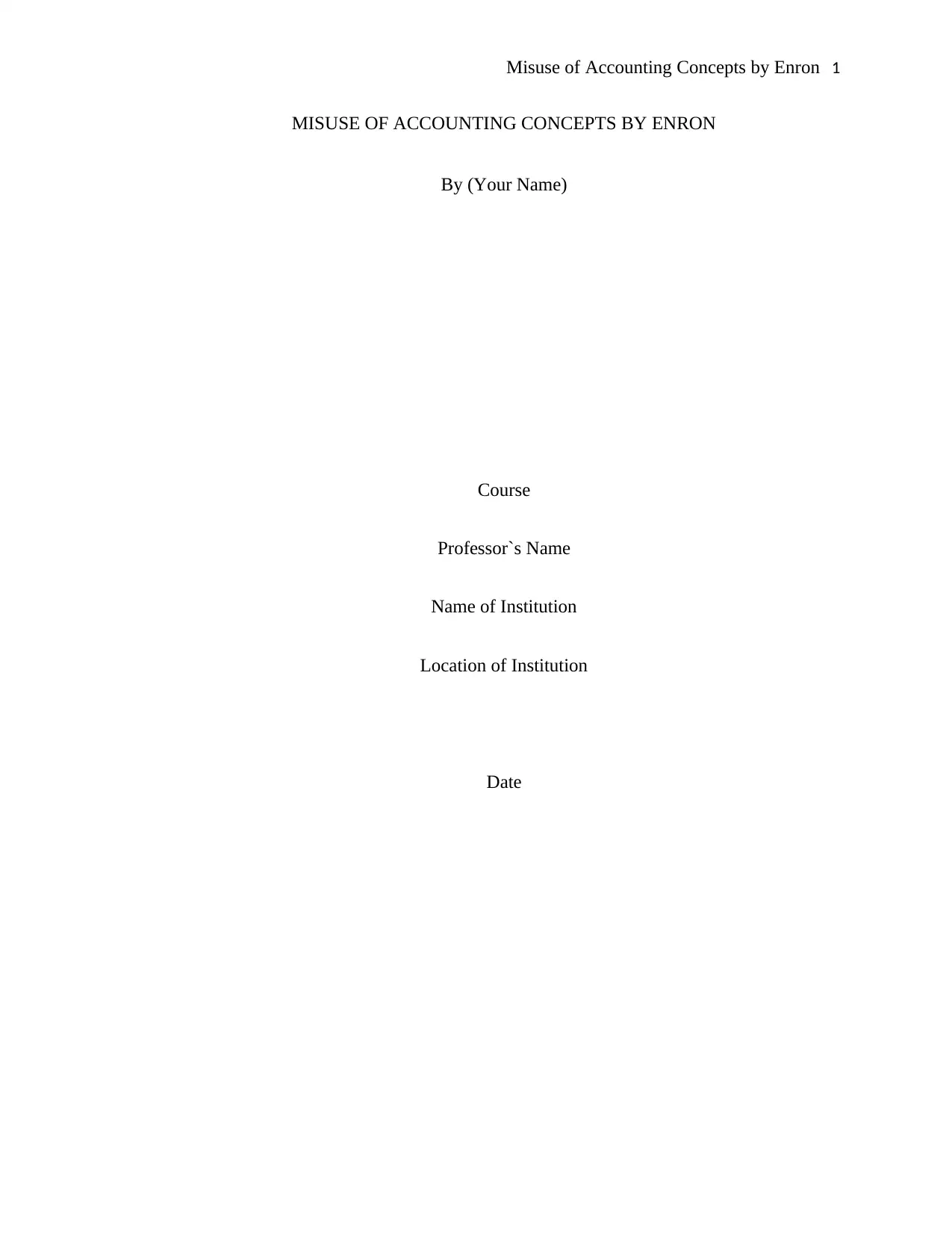
Misuse of Accounting Concepts by Enron 1
MISUSE OF ACCOUNTING CONCEPTS BY ENRON
By (Your Name)
Course
Professor`s Name
Name of Institution
Location of Institution
Date
MISUSE OF ACCOUNTING CONCEPTS BY ENRON
By (Your Name)
Course
Professor`s Name
Name of Institution
Location of Institution
Date
Paraphrase This Document
Need a fresh take? Get an instant paraphrase of this document with our AI Paraphraser
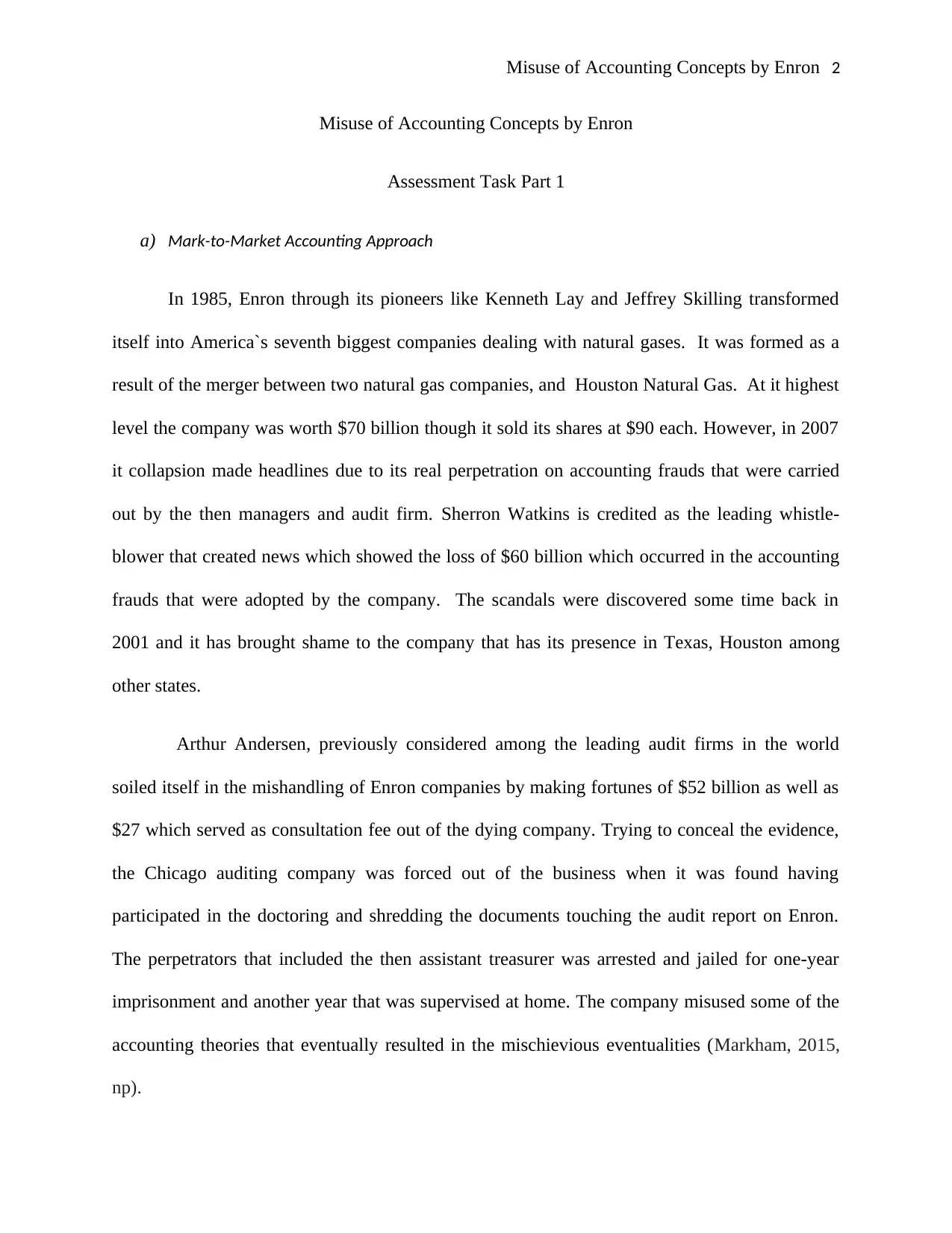
Misuse of Accounting Concepts by Enron 2
Misuse of Accounting Concepts by Enron
Assessment Task Part 1
a) Mark-to-Market Accounting Approach
In 1985, Enron through its pioneers like Kenneth Lay and Jeffrey Skilling transformed
itself into America`s seventh biggest companies dealing with natural gases. It was formed as a
result of the merger between two natural gas companies, and Houston Natural Gas. At it highest
level the company was worth $70 billion though it sold its shares at $90 each. However, in 2007
it collapsion made headlines due to its real perpetration on accounting frauds that were carried
out by the then managers and audit firm. Sherron Watkins is credited as the leading whistle-
blower that created news which showed the loss of $60 billion which occurred in the accounting
frauds that were adopted by the company. The scandals were discovered some time back in
2001 and it has brought shame to the company that has its presence in Texas, Houston among
other states.
Arthur Andersen, previously considered among the leading audit firms in the world
soiled itself in the mishandling of Enron companies by making fortunes of $52 billion as well as
$27 which served as consultation fee out of the dying company. Trying to conceal the evidence,
the Chicago auditing company was forced out of the business when it was found having
participated in the doctoring and shredding the documents touching the audit report on Enron.
The perpetrators that included the then assistant treasurer was arrested and jailed for one-year
imprisonment and another year that was supervised at home. The company misused some of the
accounting theories that eventually resulted in the mischievious eventualities (Markham, 2015,
np).
Misuse of Accounting Concepts by Enron
Assessment Task Part 1
a) Mark-to-Market Accounting Approach
In 1985, Enron through its pioneers like Kenneth Lay and Jeffrey Skilling transformed
itself into America`s seventh biggest companies dealing with natural gases. It was formed as a
result of the merger between two natural gas companies, and Houston Natural Gas. At it highest
level the company was worth $70 billion though it sold its shares at $90 each. However, in 2007
it collapsion made headlines due to its real perpetration on accounting frauds that were carried
out by the then managers and audit firm. Sherron Watkins is credited as the leading whistle-
blower that created news which showed the loss of $60 billion which occurred in the accounting
frauds that were adopted by the company. The scandals were discovered some time back in
2001 and it has brought shame to the company that has its presence in Texas, Houston among
other states.
Arthur Andersen, previously considered among the leading audit firms in the world
soiled itself in the mishandling of Enron companies by making fortunes of $52 billion as well as
$27 which served as consultation fee out of the dying company. Trying to conceal the evidence,
the Chicago auditing company was forced out of the business when it was found having
participated in the doctoring and shredding the documents touching the audit report on Enron.
The perpetrators that included the then assistant treasurer was arrested and jailed for one-year
imprisonment and another year that was supervised at home. The company misused some of the
accounting theories that eventually resulted in the mischievious eventualities (Markham, 2015,
np).
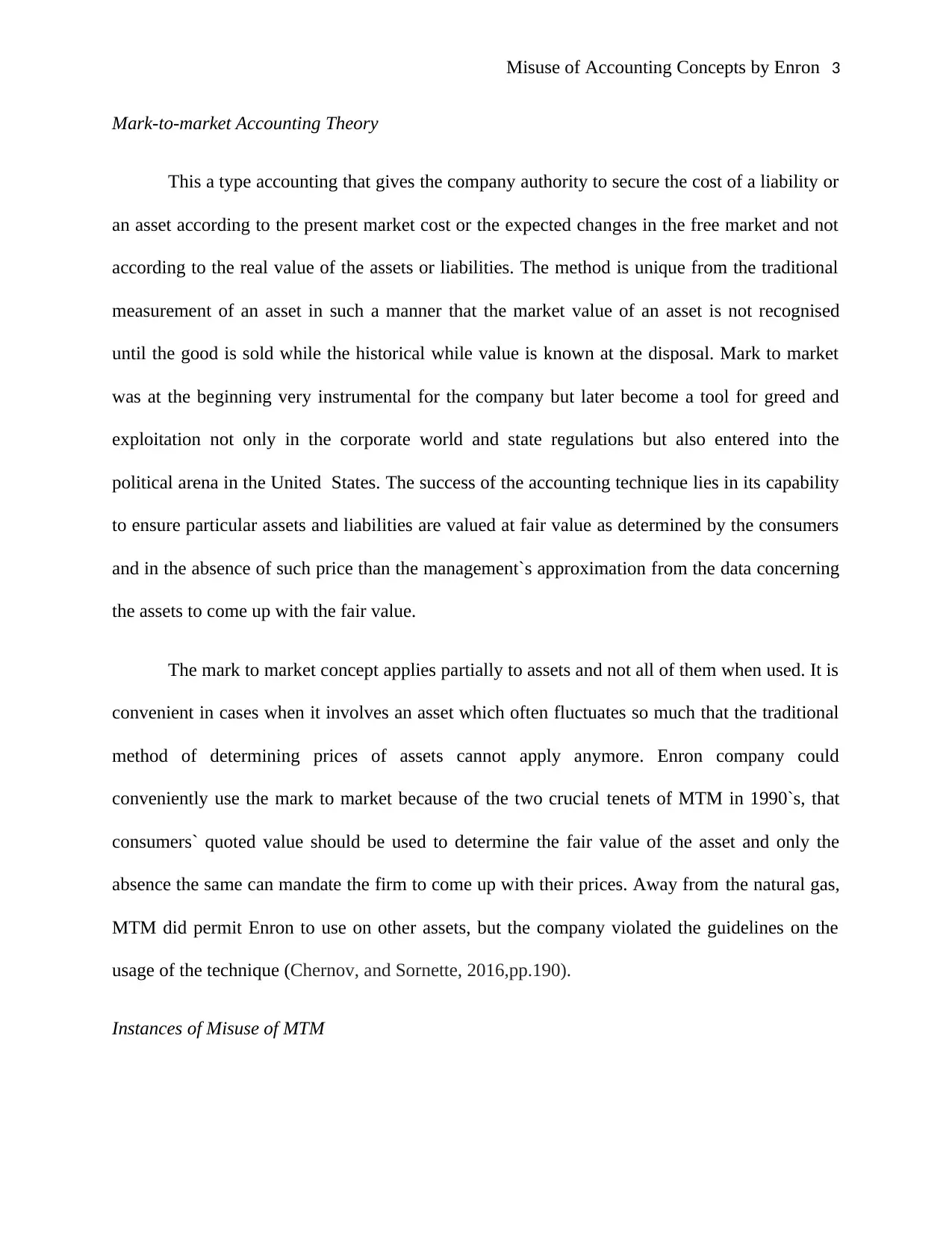
Misuse of Accounting Concepts by Enron 3
Mark-to-market Accounting Theory
This a type accounting that gives the company authority to secure the cost of a liability or
an asset according to the present market cost or the expected changes in the free market and not
according to the real value of the assets or liabilities. The method is unique from the traditional
measurement of an asset in such a manner that the market value of an asset is not recognised
until the good is sold while the historical while value is known at the disposal. Mark to market
was at the beginning very instrumental for the company but later become a tool for greed and
exploitation not only in the corporate world and state regulations but also entered into the
political arena in the United States. The success of the accounting technique lies in its capability
to ensure particular assets and liabilities are valued at fair value as determined by the consumers
and in the absence of such price than the management`s approximation from the data concerning
the assets to come up with the fair value.
The mark to market concept applies partially to assets and not all of them when used. It is
convenient in cases when it involves an asset which often fluctuates so much that the traditional
method of determining prices of assets cannot apply anymore. Enron company could
conveniently use the mark to market because of the two crucial tenets of MTM in 1990`s, that
consumers` quoted value should be used to determine the fair value of the asset and only the
absence the same can mandate the firm to come up with their prices. Away from the natural gas,
MTM did permit Enron to use on other assets, but the company violated the guidelines on the
usage of the technique (Chernov, and Sornette, 2016,pp.190).
Instances of Misuse of MTM
Mark-to-market Accounting Theory
This a type accounting that gives the company authority to secure the cost of a liability or
an asset according to the present market cost or the expected changes in the free market and not
according to the real value of the assets or liabilities. The method is unique from the traditional
measurement of an asset in such a manner that the market value of an asset is not recognised
until the good is sold while the historical while value is known at the disposal. Mark to market
was at the beginning very instrumental for the company but later become a tool for greed and
exploitation not only in the corporate world and state regulations but also entered into the
political arena in the United States. The success of the accounting technique lies in its capability
to ensure particular assets and liabilities are valued at fair value as determined by the consumers
and in the absence of such price than the management`s approximation from the data concerning
the assets to come up with the fair value.
The mark to market concept applies partially to assets and not all of them when used. It is
convenient in cases when it involves an asset which often fluctuates so much that the traditional
method of determining prices of assets cannot apply anymore. Enron company could
conveniently use the mark to market because of the two crucial tenets of MTM in 1990`s, that
consumers` quoted value should be used to determine the fair value of the asset and only the
absence the same can mandate the firm to come up with their prices. Away from the natural gas,
MTM did permit Enron to use on other assets, but the company violated the guidelines on the
usage of the technique (Chernov, and Sornette, 2016,pp.190).
Instances of Misuse of MTM
⊘ This is a preview!⊘
Do you want full access?
Subscribe today to unlock all pages.

Trusted by 1+ million students worldwide
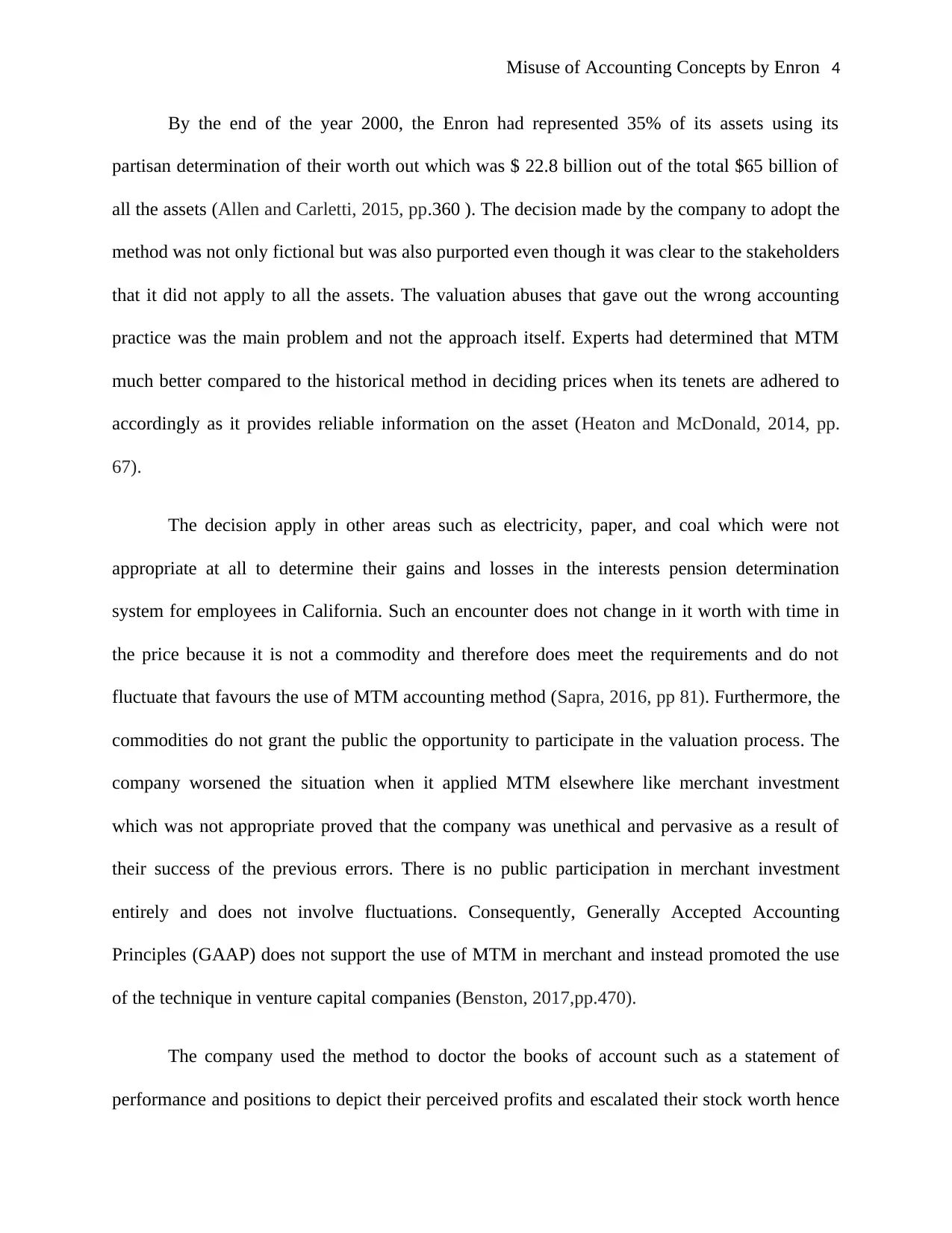
Misuse of Accounting Concepts by Enron 4
By the end of the year 2000, the Enron had represented 35% of its assets using its
partisan determination of their worth out which was $ 22.8 billion out of the total $65 billion of
all the assets (Allen and Carletti, 2015, pp.360 ). The decision made by the company to adopt the
method was not only fictional but was also purported even though it was clear to the stakeholders
that it did not apply to all the assets. The valuation abuses that gave out the wrong accounting
practice was the main problem and not the approach itself. Experts had determined that MTM
much better compared to the historical method in deciding prices when its tenets are adhered to
accordingly as it provides reliable information on the asset (Heaton and McDonald, 2014, pp.
67).
The decision apply in other areas such as electricity, paper, and coal which were not
appropriate at all to determine their gains and losses in the interests pension determination
system for employees in California. Such an encounter does not change in it worth with time in
the price because it is not a commodity and therefore does meet the requirements and do not
fluctuate that favours the use of MTM accounting method (Sapra, 2016, pp 81). Furthermore, the
commodities do not grant the public the opportunity to participate in the valuation process. The
company worsened the situation when it applied MTM elsewhere like merchant investment
which was not appropriate proved that the company was unethical and pervasive as a result of
their success of the previous errors. There is no public participation in merchant investment
entirely and does not involve fluctuations. Consequently, Generally Accepted Accounting
Principles (GAAP) does not support the use of MTM in merchant and instead promoted the use
of the technique in venture capital companies (Benston, 2017,pp.470).
The company used the method to doctor the books of account such as a statement of
performance and positions to depict their perceived profits and escalated their stock worth hence
By the end of the year 2000, the Enron had represented 35% of its assets using its
partisan determination of their worth out which was $ 22.8 billion out of the total $65 billion of
all the assets (Allen and Carletti, 2015, pp.360 ). The decision made by the company to adopt the
method was not only fictional but was also purported even though it was clear to the stakeholders
that it did not apply to all the assets. The valuation abuses that gave out the wrong accounting
practice was the main problem and not the approach itself. Experts had determined that MTM
much better compared to the historical method in deciding prices when its tenets are adhered to
accordingly as it provides reliable information on the asset (Heaton and McDonald, 2014, pp.
67).
The decision apply in other areas such as electricity, paper, and coal which were not
appropriate at all to determine their gains and losses in the interests pension determination
system for employees in California. Such an encounter does not change in it worth with time in
the price because it is not a commodity and therefore does meet the requirements and do not
fluctuate that favours the use of MTM accounting method (Sapra, 2016, pp 81). Furthermore, the
commodities do not grant the public the opportunity to participate in the valuation process. The
company worsened the situation when it applied MTM elsewhere like merchant investment
which was not appropriate proved that the company was unethical and pervasive as a result of
their success of the previous errors. There is no public participation in merchant investment
entirely and does not involve fluctuations. Consequently, Generally Accepted Accounting
Principles (GAAP) does not support the use of MTM in merchant and instead promoted the use
of the technique in venture capital companies (Benston, 2017,pp.470).
The company used the method to doctor the books of account such as a statement of
performance and positions to depict their perceived profits and escalated their stock worth hence
Paraphrase This Document
Need a fresh take? Get an instant paraphrase of this document with our AI Paraphraser
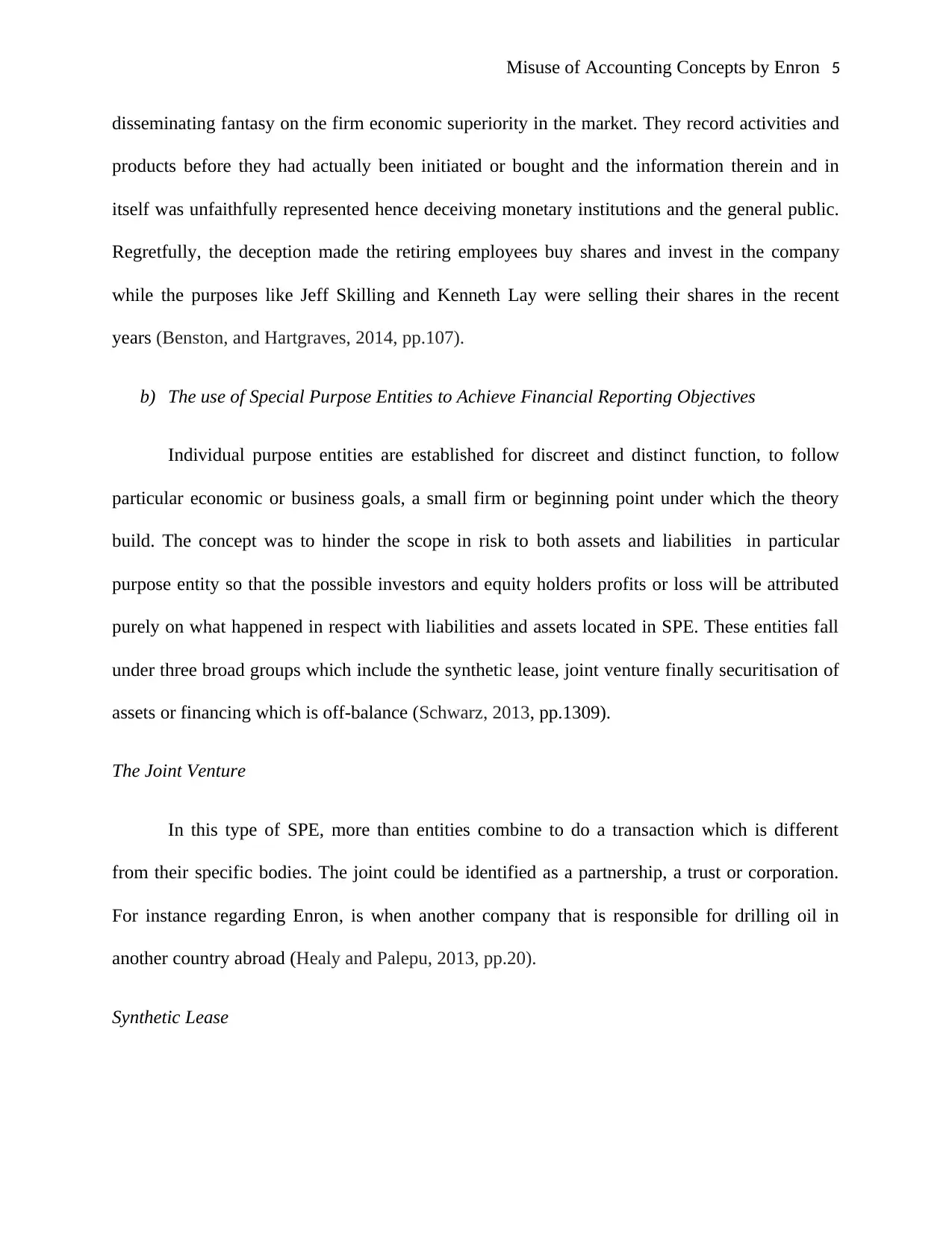
Misuse of Accounting Concepts by Enron 5
disseminating fantasy on the firm economic superiority in the market. They record activities and
products before they had actually been initiated or bought and the information therein and in
itself was unfaithfully represented hence deceiving monetary institutions and the general public.
Regretfully, the deception made the retiring employees buy shares and invest in the company
while the purposes like Jeff Skilling and Kenneth Lay were selling their shares in the recent
years (Benston, and Hartgraves, 2014, pp.107).
b) The use of Special Purpose Entities to Achieve Financial Reporting Objectives
Individual purpose entities are established for discreet and distinct function, to follow
particular economic or business goals, a small firm or beginning point under which the theory
build. The concept was to hinder the scope in risk to both assets and liabilities in particular
purpose entity so that the possible investors and equity holders profits or loss will be attributed
purely on what happened in respect with liabilities and assets located in SPE. These entities fall
under three broad groups which include the synthetic lease, joint venture finally securitisation of
assets or financing which is off-balance (Schwarz, 2013, pp.1309).
The Joint Venture
In this type of SPE, more than entities combine to do a transaction which is different
from their specific bodies. The joint could be identified as a partnership, a trust or corporation.
For instance regarding Enron, is when another company that is responsible for drilling oil in
another country abroad (Healy and Palepu, 2013, pp.20).
Synthetic Lease
disseminating fantasy on the firm economic superiority in the market. They record activities and
products before they had actually been initiated or bought and the information therein and in
itself was unfaithfully represented hence deceiving monetary institutions and the general public.
Regretfully, the deception made the retiring employees buy shares and invest in the company
while the purposes like Jeff Skilling and Kenneth Lay were selling their shares in the recent
years (Benston, and Hartgraves, 2014, pp.107).
b) The use of Special Purpose Entities to Achieve Financial Reporting Objectives
Individual purpose entities are established for discreet and distinct function, to follow
particular economic or business goals, a small firm or beginning point under which the theory
build. The concept was to hinder the scope in risk to both assets and liabilities in particular
purpose entity so that the possible investors and equity holders profits or loss will be attributed
purely on what happened in respect with liabilities and assets located in SPE. These entities fall
under three broad groups which include the synthetic lease, joint venture finally securitisation of
assets or financing which is off-balance (Schwarz, 2013, pp.1309).
The Joint Venture
In this type of SPE, more than entities combine to do a transaction which is different
from their specific bodies. The joint could be identified as a partnership, a trust or corporation.
For instance regarding Enron, is when another company that is responsible for drilling oil in
another country abroad (Healy and Palepu, 2013, pp.20).
Synthetic Lease
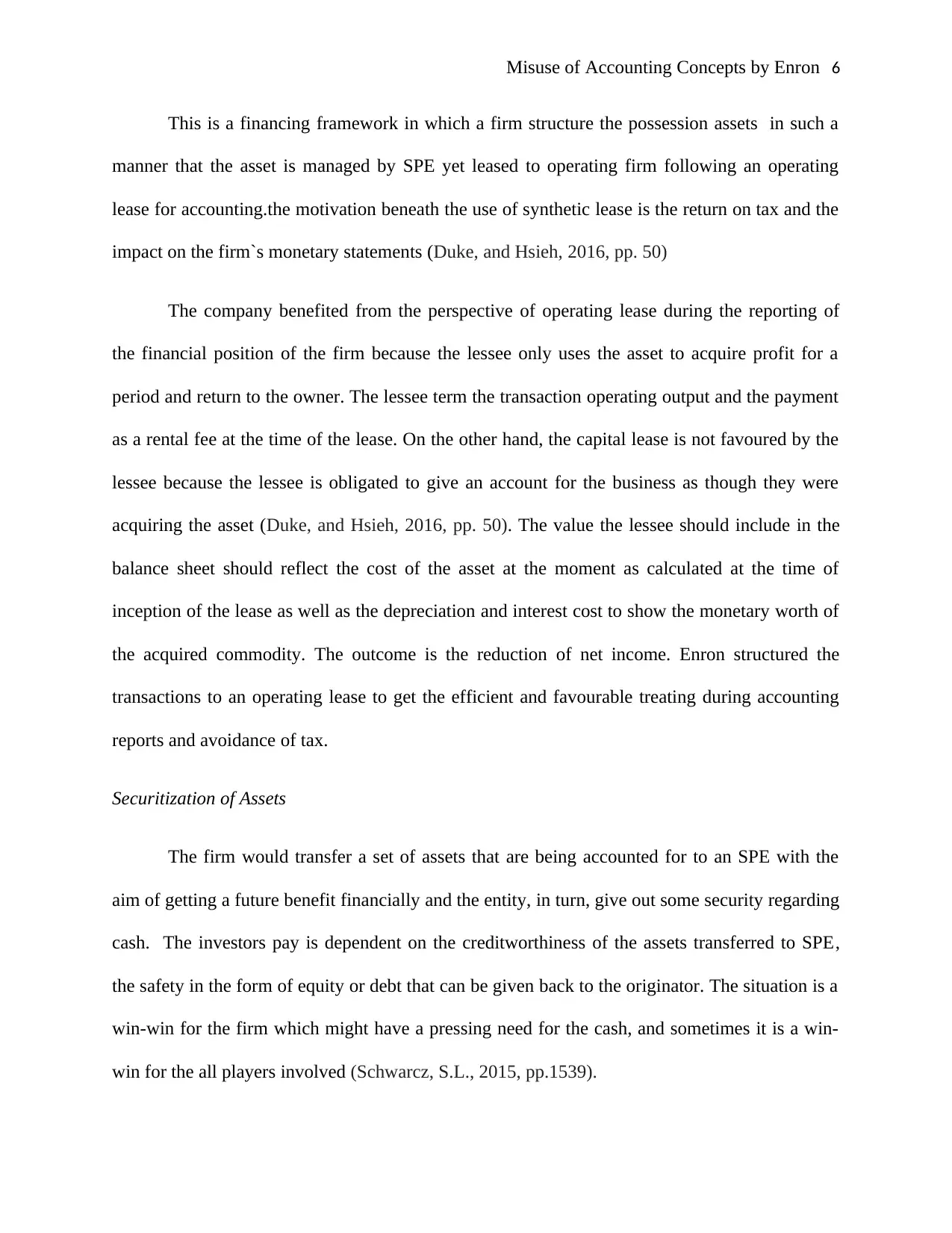
Misuse of Accounting Concepts by Enron 6
This is a financing framework in which a firm structure the possession assets in such a
manner that the asset is managed by SPE yet leased to operating firm following an operating
lease for accounting.the motivation beneath the use of synthetic lease is the return on tax and the
impact on the firm`s monetary statements (Duke, and Hsieh, 2016, pp. 50)
The company benefited from the perspective of operating lease during the reporting of
the financial position of the firm because the lessee only uses the asset to acquire profit for a
period and return to the owner. The lessee term the transaction operating output and the payment
as a rental fee at the time of the lease. On the other hand, the capital lease is not favoured by the
lessee because the lessee is obligated to give an account for the business as though they were
acquiring the asset (Duke, and Hsieh, 2016, pp. 50). The value the lessee should include in the
balance sheet should reflect the cost of the asset at the moment as calculated at the time of
inception of the lease as well as the depreciation and interest cost to show the monetary worth of
the acquired commodity. The outcome is the reduction of net income. Enron structured the
transactions to an operating lease to get the efficient and favourable treating during accounting
reports and avoidance of tax.
Securitization of Assets
The firm would transfer a set of assets that are being accounted for to an SPE with the
aim of getting a future benefit financially and the entity, in turn, give out some security regarding
cash. The investors pay is dependent on the creditworthiness of the assets transferred to SPE,
the safety in the form of equity or debt that can be given back to the originator. The situation is a
win-win for the firm which might have a pressing need for the cash, and sometimes it is a win-
win for the all players involved (Schwarcz, S.L., 2015, pp.1539).
This is a financing framework in which a firm structure the possession assets in such a
manner that the asset is managed by SPE yet leased to operating firm following an operating
lease for accounting.the motivation beneath the use of synthetic lease is the return on tax and the
impact on the firm`s monetary statements (Duke, and Hsieh, 2016, pp. 50)
The company benefited from the perspective of operating lease during the reporting of
the financial position of the firm because the lessee only uses the asset to acquire profit for a
period and return to the owner. The lessee term the transaction operating output and the payment
as a rental fee at the time of the lease. On the other hand, the capital lease is not favoured by the
lessee because the lessee is obligated to give an account for the business as though they were
acquiring the asset (Duke, and Hsieh, 2016, pp. 50). The value the lessee should include in the
balance sheet should reflect the cost of the asset at the moment as calculated at the time of
inception of the lease as well as the depreciation and interest cost to show the monetary worth of
the acquired commodity. The outcome is the reduction of net income. Enron structured the
transactions to an operating lease to get the efficient and favourable treating during accounting
reports and avoidance of tax.
Securitization of Assets
The firm would transfer a set of assets that are being accounted for to an SPE with the
aim of getting a future benefit financially and the entity, in turn, give out some security regarding
cash. The investors pay is dependent on the creditworthiness of the assets transferred to SPE,
the safety in the form of equity or debt that can be given back to the originator. The situation is a
win-win for the firm which might have a pressing need for the cash, and sometimes it is a win-
win for the all players involved (Schwarcz, S.L., 2015, pp.1539).
⊘ This is a preview!⊘
Do you want full access?
Subscribe today to unlock all pages.

Trusted by 1+ million students worldwide
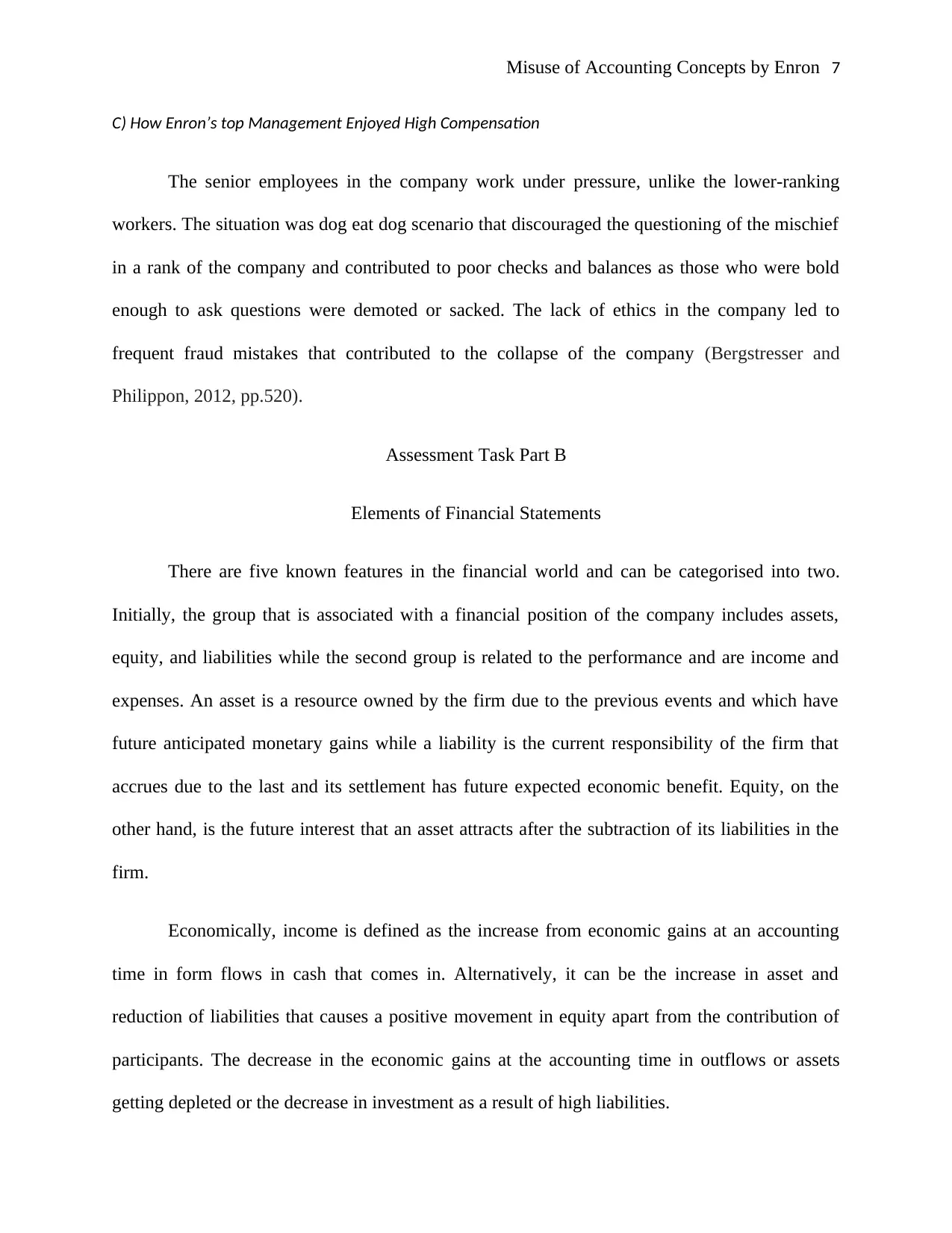
Misuse of Accounting Concepts by Enron 7
C) How Enron’s top Management Enjoyed High Compensation
The senior employees in the company work under pressure, unlike the lower-ranking
workers. The situation was dog eat dog scenario that discouraged the questioning of the mischief
in a rank of the company and contributed to poor checks and balances as those who were bold
enough to ask questions were demoted or sacked. The lack of ethics in the company led to
frequent fraud mistakes that contributed to the collapse of the company (Bergstresser and
Philippon, 2012, pp.520).
Assessment Task Part B
Elements of Financial Statements
There are five known features in the financial world and can be categorised into two.
Initially, the group that is associated with a financial position of the company includes assets,
equity, and liabilities while the second group is related to the performance and are income and
expenses. An asset is a resource owned by the firm due to the previous events and which have
future anticipated monetary gains while a liability is the current responsibility of the firm that
accrues due to the last and its settlement has future expected economic benefit. Equity, on the
other hand, is the future interest that an asset attracts after the subtraction of its liabilities in the
firm.
Economically, income is defined as the increase from economic gains at an accounting
time in form flows in cash that comes in. Alternatively, it can be the increase in asset and
reduction of liabilities that causes a positive movement in equity apart from the contribution of
participants. The decrease in the economic gains at the accounting time in outflows or assets
getting depleted or the decrease in investment as a result of high liabilities.
C) How Enron’s top Management Enjoyed High Compensation
The senior employees in the company work under pressure, unlike the lower-ranking
workers. The situation was dog eat dog scenario that discouraged the questioning of the mischief
in a rank of the company and contributed to poor checks and balances as those who were bold
enough to ask questions were demoted or sacked. The lack of ethics in the company led to
frequent fraud mistakes that contributed to the collapse of the company (Bergstresser and
Philippon, 2012, pp.520).
Assessment Task Part B
Elements of Financial Statements
There are five known features in the financial world and can be categorised into two.
Initially, the group that is associated with a financial position of the company includes assets,
equity, and liabilities while the second group is related to the performance and are income and
expenses. An asset is a resource owned by the firm due to the previous events and which have
future anticipated monetary gains while a liability is the current responsibility of the firm that
accrues due to the last and its settlement has future expected economic benefit. Equity, on the
other hand, is the future interest that an asset attracts after the subtraction of its liabilities in the
firm.
Economically, income is defined as the increase from economic gains at an accounting
time in form flows in cash that comes in. Alternatively, it can be the increase in asset and
reduction of liabilities that causes a positive movement in equity apart from the contribution of
participants. The decrease in the economic gains at the accounting time in outflows or assets
getting depleted or the decrease in investment as a result of high liabilities.
Paraphrase This Document
Need a fresh take? Get an instant paraphrase of this document with our AI Paraphraser
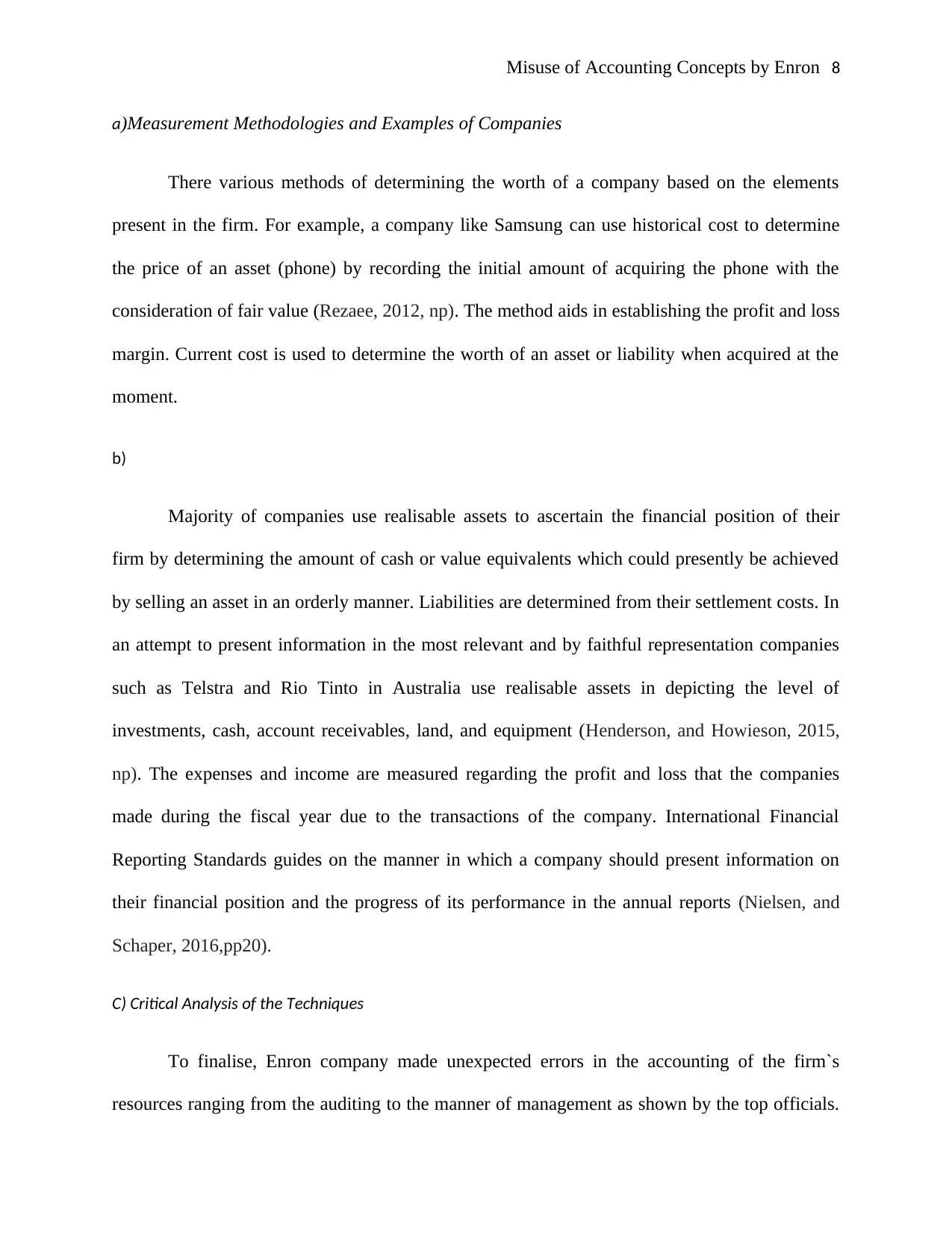
Misuse of Accounting Concepts by Enron 8
a)Measurement Methodologies and Examples of Companies
There various methods of determining the worth of a company based on the elements
present in the firm. For example, a company like Samsung can use historical cost to determine
the price of an asset (phone) by recording the initial amount of acquiring the phone with the
consideration of fair value (Rezaee, 2012, np). The method aids in establishing the profit and loss
margin. Current cost is used to determine the worth of an asset or liability when acquired at the
moment.
b)
Majority of companies use realisable assets to ascertain the financial position of their
firm by determining the amount of cash or value equivalents which could presently be achieved
by selling an asset in an orderly manner. Liabilities are determined from their settlement costs. In
an attempt to present information in the most relevant and by faithful representation companies
such as Telstra and Rio Tinto in Australia use realisable assets in depicting the level of
investments, cash, account receivables, land, and equipment (Henderson, and Howieson, 2015,
np). The expenses and income are measured regarding the profit and loss that the companies
made during the fiscal year due to the transactions of the company. International Financial
Reporting Standards guides on the manner in which a company should present information on
their financial position and the progress of its performance in the annual reports (Nielsen, and
Schaper, 2016,pp20).
C) Critical Analysis of the Techniques
To finalise, Enron company made unexpected errors in the accounting of the firm`s
resources ranging from the auditing to the manner of management as shown by the top officials.
a)Measurement Methodologies and Examples of Companies
There various methods of determining the worth of a company based on the elements
present in the firm. For example, a company like Samsung can use historical cost to determine
the price of an asset (phone) by recording the initial amount of acquiring the phone with the
consideration of fair value (Rezaee, 2012, np). The method aids in establishing the profit and loss
margin. Current cost is used to determine the worth of an asset or liability when acquired at the
moment.
b)
Majority of companies use realisable assets to ascertain the financial position of their
firm by determining the amount of cash or value equivalents which could presently be achieved
by selling an asset in an orderly manner. Liabilities are determined from their settlement costs. In
an attempt to present information in the most relevant and by faithful representation companies
such as Telstra and Rio Tinto in Australia use realisable assets in depicting the level of
investments, cash, account receivables, land, and equipment (Henderson, and Howieson, 2015,
np). The expenses and income are measured regarding the profit and loss that the companies
made during the fiscal year due to the transactions of the company. International Financial
Reporting Standards guides on the manner in which a company should present information on
their financial position and the progress of its performance in the annual reports (Nielsen, and
Schaper, 2016,pp20).
C) Critical Analysis of the Techniques
To finalise, Enron company made unexpected errors in the accounting of the firm`s
resources ranging from the auditing to the manner of management as shown by the top officials.
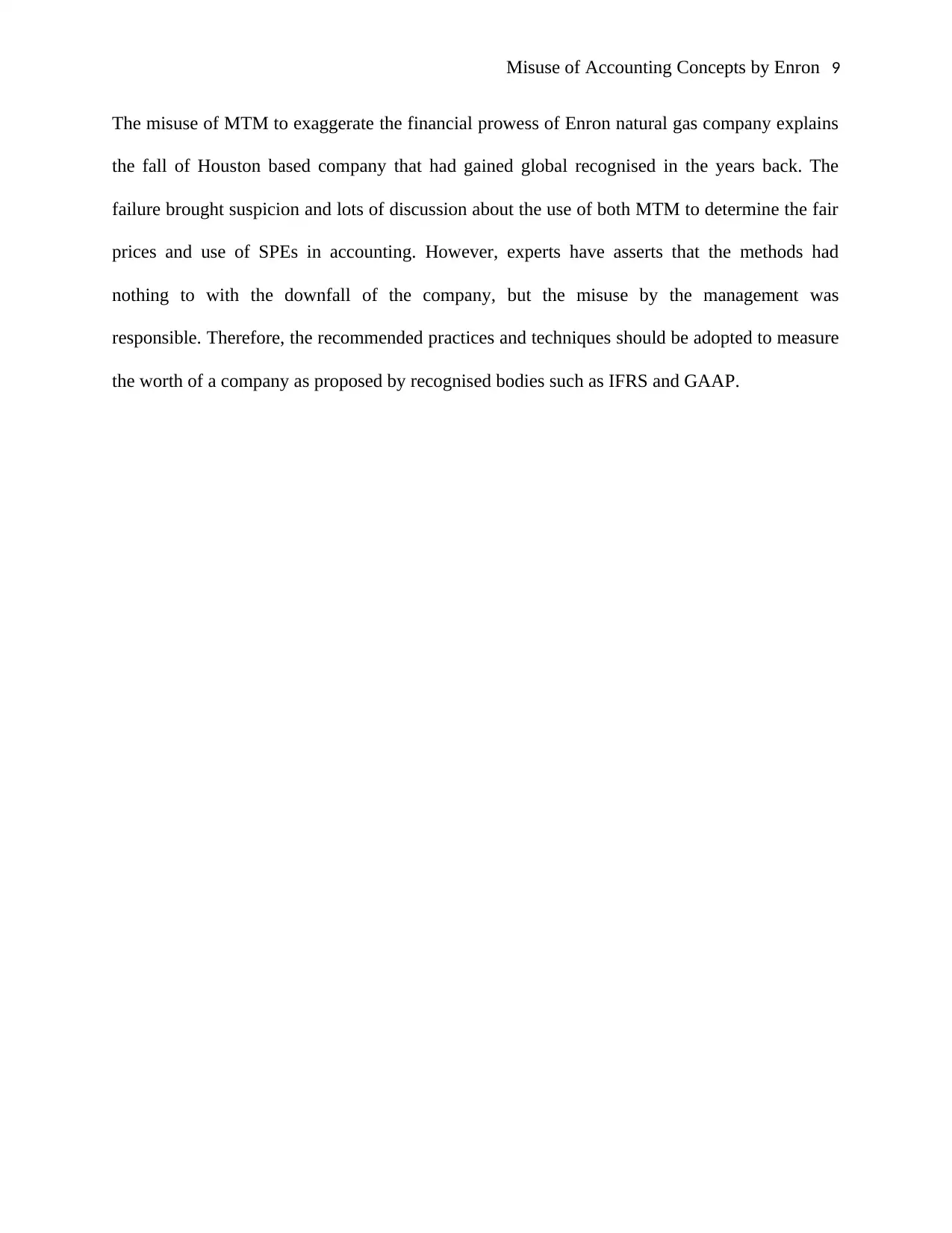
Misuse of Accounting Concepts by Enron 9
The misuse of MTM to exaggerate the financial prowess of Enron natural gas company explains
the fall of Houston based company that had gained global recognised in the years back. The
failure brought suspicion and lots of discussion about the use of both MTM to determine the fair
prices and use of SPEs in accounting. However, experts have asserts that the methods had
nothing to with the downfall of the company, but the misuse by the management was
responsible. Therefore, the recommended practices and techniques should be adopted to measure
the worth of a company as proposed by recognised bodies such as IFRS and GAAP.
The misuse of MTM to exaggerate the financial prowess of Enron natural gas company explains
the fall of Houston based company that had gained global recognised in the years back. The
failure brought suspicion and lots of discussion about the use of both MTM to determine the fair
prices and use of SPEs in accounting. However, experts have asserts that the methods had
nothing to with the downfall of the company, but the misuse by the management was
responsible. Therefore, the recommended practices and techniques should be adopted to measure
the worth of a company as proposed by recognised bodies such as IFRS and GAAP.
⊘ This is a preview!⊘
Do you want full access?
Subscribe today to unlock all pages.

Trusted by 1+ million students worldwide
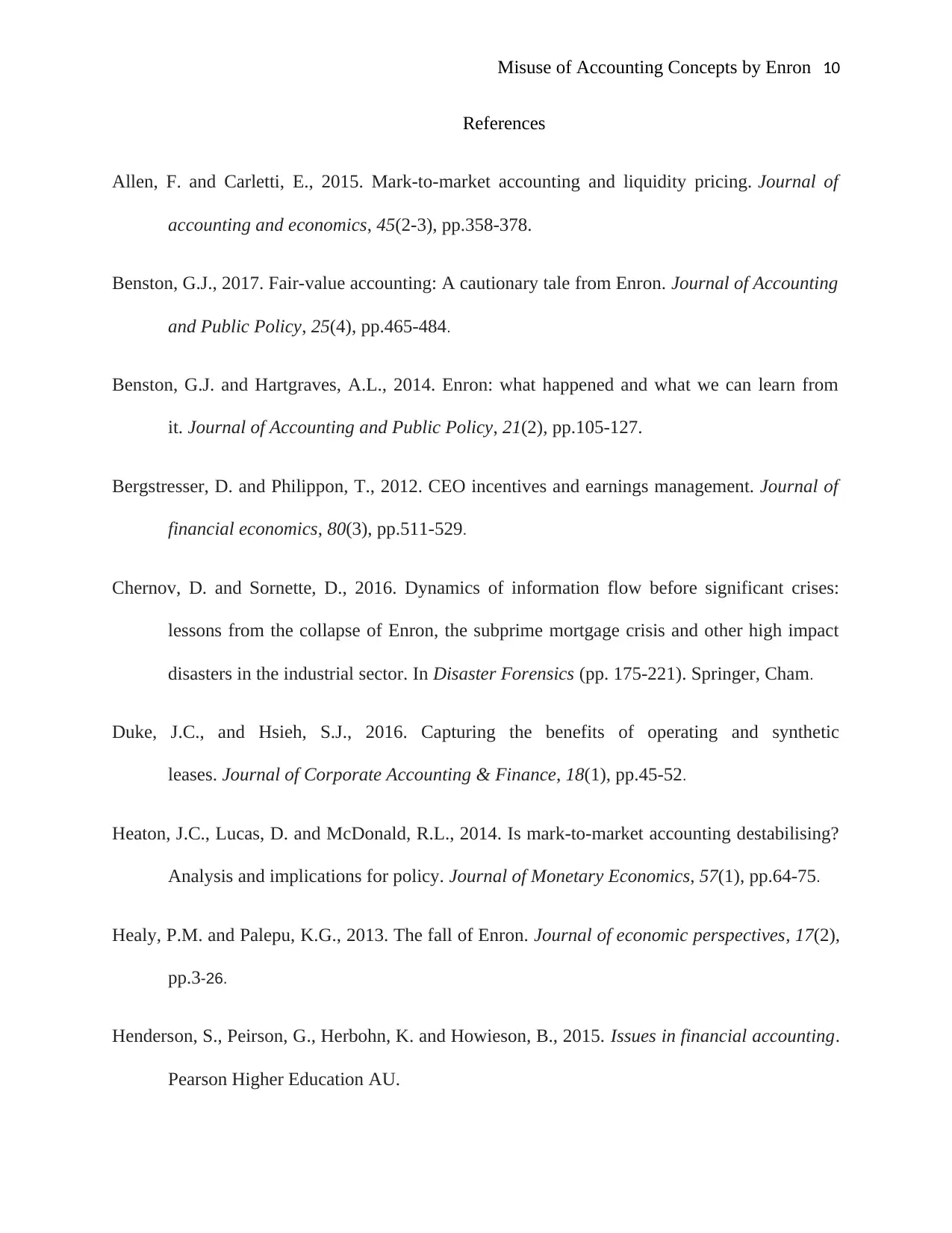
Misuse of Accounting Concepts by Enron 10
References
Allen, F. and Carletti, E., 2015. Mark-to-market accounting and liquidity pricing. Journal of
accounting and economics, 45(2-3), pp.358-378.
Benston, G.J., 2017. Fair-value accounting: A cautionary tale from Enron. Journal of Accounting
and Public Policy, 25(4), pp.465-484.
Benston, G.J. and Hartgraves, A.L., 2014. Enron: what happened and what we can learn from
it. Journal of Accounting and Public Policy, 21(2), pp.105-127.
Bergstresser, D. and Philippon, T., 2012. CEO incentives and earnings management. Journal of
financial economics, 80(3), pp.511-529.
Chernov, D. and Sornette, D., 2016. Dynamics of information flow before significant crises:
lessons from the collapse of Enron, the subprime mortgage crisis and other high impact
disasters in the industrial sector. In Disaster Forensics (pp. 175-221). Springer, Cham.
Duke, J.C., and Hsieh, S.J., 2016. Capturing the benefits of operating and synthetic
leases. Journal of Corporate Accounting & Finance, 18(1), pp.45-52.
Heaton, J.C., Lucas, D. and McDonald, R.L., 2014. Is mark-to-market accounting destabilising?
Analysis and implications for policy. Journal of Monetary Economics, 57(1), pp.64-75.
Healy, P.M. and Palepu, K.G., 2013. The fall of Enron. Journal of economic perspectives, 17(2),
pp.3-26.
Henderson, S., Peirson, G., Herbohn, K. and Howieson, B., 2015. Issues in financial accounting.
Pearson Higher Education AU.
References
Allen, F. and Carletti, E., 2015. Mark-to-market accounting and liquidity pricing. Journal of
accounting and economics, 45(2-3), pp.358-378.
Benston, G.J., 2017. Fair-value accounting: A cautionary tale from Enron. Journal of Accounting
and Public Policy, 25(4), pp.465-484.
Benston, G.J. and Hartgraves, A.L., 2014. Enron: what happened and what we can learn from
it. Journal of Accounting and Public Policy, 21(2), pp.105-127.
Bergstresser, D. and Philippon, T., 2012. CEO incentives and earnings management. Journal of
financial economics, 80(3), pp.511-529.
Chernov, D. and Sornette, D., 2016. Dynamics of information flow before significant crises:
lessons from the collapse of Enron, the subprime mortgage crisis and other high impact
disasters in the industrial sector. In Disaster Forensics (pp. 175-221). Springer, Cham.
Duke, J.C., and Hsieh, S.J., 2016. Capturing the benefits of operating and synthetic
leases. Journal of Corporate Accounting & Finance, 18(1), pp.45-52.
Heaton, J.C., Lucas, D. and McDonald, R.L., 2014. Is mark-to-market accounting destabilising?
Analysis and implications for policy. Journal of Monetary Economics, 57(1), pp.64-75.
Healy, P.M. and Palepu, K.G., 2013. The fall of Enron. Journal of economic perspectives, 17(2),
pp.3-26.
Henderson, S., Peirson, G., Herbohn, K. and Howieson, B., 2015. Issues in financial accounting.
Pearson Higher Education AU.
Paraphrase This Document
Need a fresh take? Get an instant paraphrase of this document with our AI Paraphraser
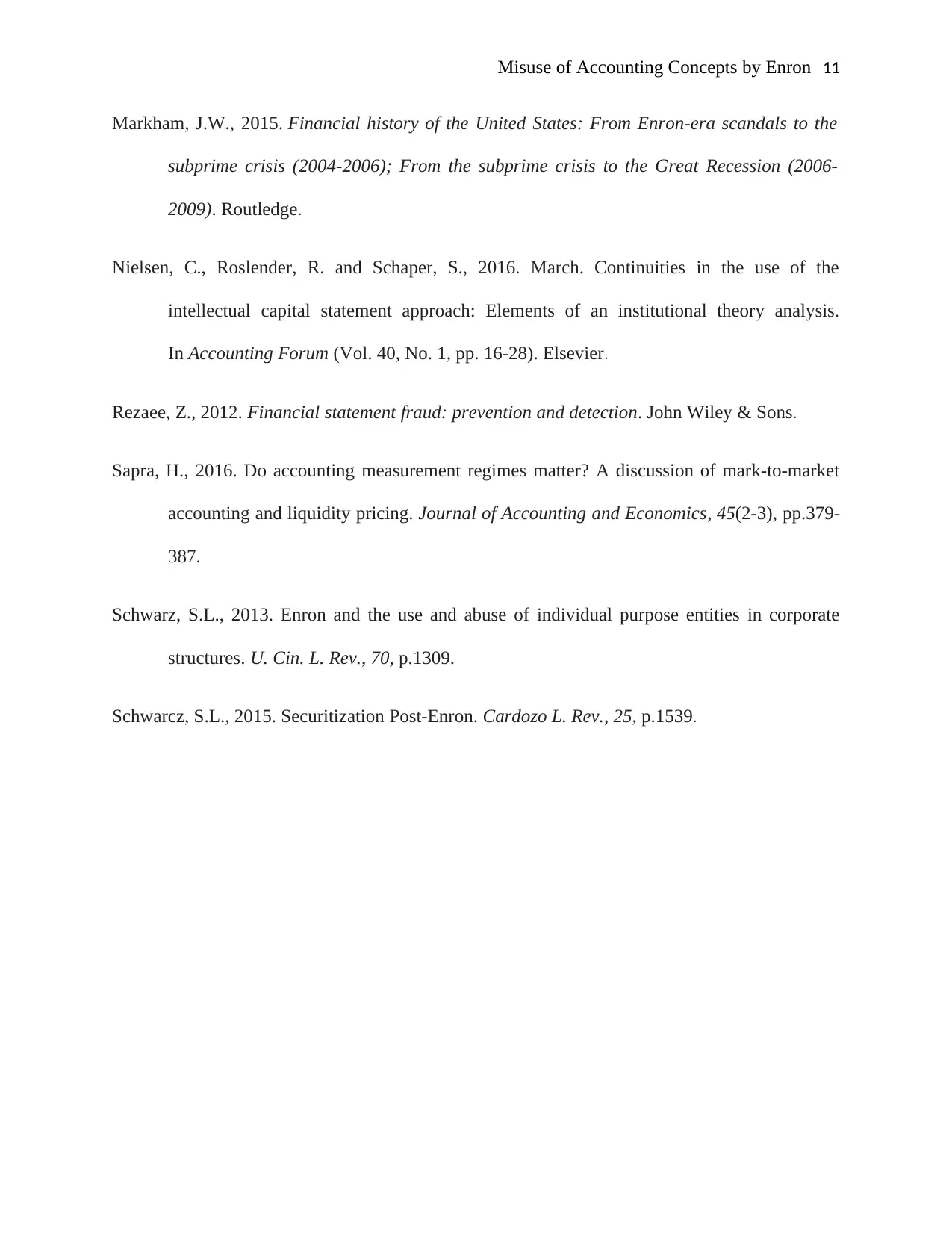
Misuse of Accounting Concepts by Enron 11
Markham, J.W., 2015. Financial history of the United States: From Enron-era scandals to the
subprime crisis (2004-2006); From the subprime crisis to the Great Recession (2006-
2009). Routledge.
Nielsen, C., Roslender, R. and Schaper, S., 2016. March. Continuities in the use of the
intellectual capital statement approach: Elements of an institutional theory analysis.
In Accounting Forum (Vol. 40, No. 1, pp. 16-28). Elsevier.
Rezaee, Z., 2012. Financial statement fraud: prevention and detection. John Wiley & Sons.
Sapra, H., 2016. Do accounting measurement regimes matter? A discussion of mark-to-market
accounting and liquidity pricing. Journal of Accounting and Economics, 45(2-3), pp.379-
387.
Schwarz, S.L., 2013. Enron and the use and abuse of individual purpose entities in corporate
structures. U. Cin. L. Rev., 70, p.1309.
Schwarcz, S.L., 2015. Securitization Post-Enron. Cardozo L. Rev., 25, p.1539.
Markham, J.W., 2015. Financial history of the United States: From Enron-era scandals to the
subprime crisis (2004-2006); From the subprime crisis to the Great Recession (2006-
2009). Routledge.
Nielsen, C., Roslender, R. and Schaper, S., 2016. March. Continuities in the use of the
intellectual capital statement approach: Elements of an institutional theory analysis.
In Accounting Forum (Vol. 40, No. 1, pp. 16-28). Elsevier.
Rezaee, Z., 2012. Financial statement fraud: prevention and detection. John Wiley & Sons.
Sapra, H., 2016. Do accounting measurement regimes matter? A discussion of mark-to-market
accounting and liquidity pricing. Journal of Accounting and Economics, 45(2-3), pp.379-
387.
Schwarz, S.L., 2013. Enron and the use and abuse of individual purpose entities in corporate
structures. U. Cin. L. Rev., 70, p.1309.
Schwarcz, S.L., 2015. Securitization Post-Enron. Cardozo L. Rev., 25, p.1539.
1 out of 11
Related Documents
Your All-in-One AI-Powered Toolkit for Academic Success.
+13062052269
info@desklib.com
Available 24*7 on WhatsApp / Email
![[object Object]](/_next/static/media/star-bottom.7253800d.svg)
Unlock your academic potential
Copyright © 2020–2025 A2Z Services. All Rights Reserved. Developed and managed by ZUCOL.





